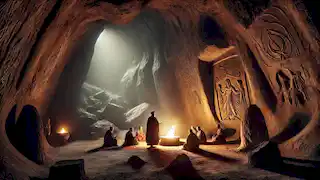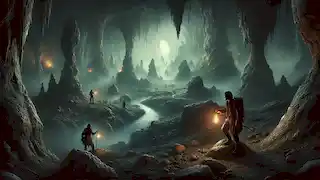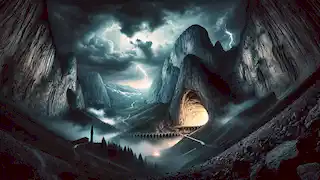{{{_intro}}}
In the remote, rugged mountains of northwestern Iran lies an extraordinary place, shrouded in mystery and reverence. The Cave of Hazrat Soleyman, named after the revered Prophet Solomon (known as Hazrat Soleyman in Persian), is a sacred site whose origins, stories, and hidden depths have captured the imaginations of those who have heard its legend. Located near the ancient town of Takab, this cave has been a focal point of both spiritual devotion and mystery for millennia.
The legend of the Cave of Hazrat Soleyman spans not only centuries but also intertwines multiple religious and cultural traditions. From its ancient Zoroastrian roots to its place in Islamic mythology, the cave has witnessed the passage of time, seeing its sacred walls touched by the hands of priests, kings, and pilgrims. Beyond the myths, however, lies the intrigue of what truly rests within this natural marvel — an undiscovered, hidden truth, guarded by the invisible forces of nature and legend.
In this tale, we will journey through the cave’s enigmatic origins, its profound spiritual significance, the supernatural beings that are said to guard it, and the archaeological puzzles that remain unsolved. This is a story of wonder, mystery, faith, and the eternal quest for the unknown.
The Pre-Islamic Roots of the Cave
Before the rise of Islam, Persia was home to one of the world’s oldest monotheistic religions: Zoroastrianism. This ancient faith, centered around the teachings of the prophet Zoroaster, revered the elements of fire, water, earth, and air as sacred manifestations of the divine. Caves, as natural structures, held special significance for the Zoroastrians, who believed them to be the perfect convergence points of these elements.

The Cave of Hazrat Soleyman, nestled deep within the rugged mountains, was one such place. Though we now know it by its Islamic name, ancient Zoroastrians believed that the cave was sacred to Ahura Mazda, the supreme god of their faith. The cave, with its imposing entrance and labyrinthine passages, was considered a sanctuary where the divine presence could be felt most strongly. It was a place for contemplation, prayer, and communion with the spiritual forces of the earth.
Early Zoroastrian priests are thought to have used the cave as a temple, performing rituals to honor the forces of nature and the divine. They would bring offerings of sacred fire, incense, and water into the cavern, seeking to maintain balance in the world through these acts of devotion. The cave’s acoustics, which amplified even the faintest whispers, likely contributed to its mystical atmosphere, making it a place where worshippers could feel truly connected to the unseen world.
Yet, despite the reverence with which the cave was treated, much of its early history remains lost to time. The ancient Zoroastrian texts that might have documented the cave’s significance have either been destroyed or remain undiscovered. What we do know is that long before the arrival of Islam, the cave was a sacred space, a portal between the physical world and the spiritual realm.
The Arrival of Islam and the Legend of Hazrat Soleyman
With the advent of Islam in the 7th century, much of Persia’s cultural and religious landscape shifted. As the new religion took root, many pre-Islamic sites were reinterpreted through the lens of Islamic teachings. The Cave of Hazrat Soleyman was one such site.
In Islamic tradition, Prophet Soleyman (Solomon) is a figure of immense significance. He is regarded as a king endowed with divine wisdom, capable of controlling both animals and jinn, the supernatural beings made of smokeless fire. The Qur’an and various Islamic texts describe Soleyman as a ruler of immense power and grace, gifted with the ability to command the elements and communicate with creatures beyond the human realm.
According to legend, Soleyman visited the cave during his reign and used it as a place of retreat and reflection. Some say he sought refuge within its depths during times of great spiritual trial, while others believe that he used the cave as a meeting place where he summoned and commanded the jinn. It is said that the Prophet, through his wisdom and divine power, left behind relics within the cave — artifacts of immense spiritual and temporal significance. These relics, according to the legend, remain hidden deep within the cave, guarded by powerful forces, including the jinn themselves.
The Jinn and Their Role in the Cave’s Mythology
The mention of jinn in connection with the Cave of Hazrat Soleyman is no small matter. In Islamic theology and folklore, the jinn are enigmatic beings created from smokeless fire, capable of free will, much like humans. They live in a realm that is separate from ours, though it intersects with our world in certain places, particularly in locations where the natural and supernatural meet. Caves, like Hazrat Soleyman's, are often considered one of these places.

The jinn, according to the stories, were servants of Prophet Soleyman, bound to obey his commands through the power bestowed upon him by God. In some tales, it is said that Soleyman ordered the jinn to build a palace deep within the cave — a palace so grand and otherworldly that no human eye has ever seen it. It was designed to be a retreat, a hidden sanctuary where only the most pious and wise could venture.
However, not all jinn were willing servants. The tales speak of rebellious jinn who resented their servitude and sought to escape Soleyman’s command. It is believed that some of these jinn remain trapped within the cave, guarding the hidden relics and waiting for a time when they might be freed from their bonds. Locals tell stories of strange occurrences near the cave: whispers carried on the wind, the feeling of being watched, and the sudden appearance of inexplicable shadows that move of their own accord. These tales, while often dismissed as superstition, have given the cave an aura of danger and intrigue, especially for those who believe in the power of the jinn.
One of the most chilling aspects of the legend is the belief that the jinn can choose who is allowed to enter the deeper parts of the cave. Those with pure intentions may pass through unharmed, but those driven by greed or malice are said to be trapped forever, lost in the labyrinthine depths of the cavern. Some locals even claim that treasure hunters who ventured into the cave in search of Soleyman’s relics never returned, their fates sealed by the jinn’s wrath.
The Cave as a Pilgrimage Site
Over the centuries, the Cave of Hazrat Soleyman has attracted pilgrims from all over the world. For many, the cave represents a place of spiritual power, where one can feel closer to God and the prophets. Islamic scholars and mystics have long visited the site, seeking to understand its hidden secrets and to commune with the divine forces that are believed to dwell within its walls.
For many pilgrims, the cave is not merely a historical or archaeological curiosity — it is a place where miracles can happen. Stories abound of people who have come to the cave seeking blessings, healing, or guidance and have found their prayers answered. Some claim to have experienced visions or mystical experiences while meditating within the cave’s silent chambers, while others report feeling a profound sense of peace and connection to the divine.
One of the most persistent legends is that of the healing spring said to exist deep within the cave. According to local lore, this spring, hidden from plain sight, has waters that can cure illnesses, both physical and spiritual. Pilgrims often bring small containers to collect the water, hoping that it will bring them health and good fortune. However, finding the spring is no easy task — it is said that only those who are pure of heart can see it, and even then, it may disappear if approached with selfish intent.
The Mysterious Relics of Hazrat Soleyman
Perhaps the most tantalizing aspect of the cave’s mythology is the belief that Hazrat Soleyman left behind powerful relics within its depths. These relics, according to legend, are imbued with divine wisdom and power, capable of granting knowledge or even control over the elements. Some believe that the relics include ancient scrolls or books of magic, written in a language only the most enlightened can understand. Others speculate that the relics may include objects of immense power, such as Solomon’s ring, which was said to grant him authority over the jinn and the natural world.
The exact nature of these relics remains a mystery, and their existence has never been conclusively proven. Yet, the stories persist, drawing treasure hunters and spiritual seekers alike to the cave. One particularly famous tale recounts the story of a group of explorers in the late 19th century who entered the cave in search of the relics. They ventured deep into the cavern, mapping its twisting passages and descending further than anyone had before. However, after weeks of exploration, the group disappeared without a trace. Despite extensive searches, no evidence of their fate was ever found. To this day, the locals believe that the jinn themselves took the explorers, punishing them for their hubris in trying to claim the relics.
Modern archaeologists have also taken an interest in the cave, hoping to separate fact from fiction. Over the years, several expeditions have attempted to uncover the secrets of the Cave of Hazrat Soleyman. Some have discovered ancient artifacts near the cave’s entrance, such as pottery and tools that date back thousands of years. These findings suggest that the cave was indeed used as a place of worship and ritual, possibly as far back as the Zoroastrian era.
However, despite numerous attempts, no one has been able to fully map the cave’s interior. The deeper chambers remain inaccessible, and the true extent of the cave’s underground network is still unknown. Some explorers have reported strange occurrences while inside the cave, such as equipment malfunctions, disorienting echoes, and a feeling of being watched. These reports, combined with the cave’s natural beauty and rich mythology, continue to fuel speculation about what may lie hidden beneath the surface.
Nature’s Role in the Cave’s Mystical Aura
While the legends of Hazrat Soleyman and the jinn are captivating, the Cave of Hazrat Soleyman is also a marvel of natural beauty. The cave is part of a larger geological formation, shaped over millennia by the forces of wind, water, and tectonic activity. The result is a breathtaking landscape of towering mountains, deep valleys, and mysterious rock formations.

The cave’s interior is equally awe-inspiring. Visitors are greeted by a labyrinth of narrow passageways, vast chambers, and stunning stalactites and stalagmites. The rock formations inside the cave seem almost otherworldly, as though they were shaped by supernatural forces. In some places, the walls of the cave are covered in strange markings, which some believe are ancient inscriptions left by early worshippers or the jinn themselves.
Water plays an important role in the cave’s mystique. Throughout the cave, there are small pools and streams of crystal-clear water, believed by many to have healing properties. The acoustics inside the cave are also remarkable, with sounds echoing and reverberating in ways that can be both eerie and beautiful. Some visitors have reported hearing strange, melodic tones emanating from the depths of the cave, which they attribute to the jinn or the spirits of ancient priests.
Modern-Day Explorations and the Unsolved Mysteries
Despite centuries of exploration and speculation, the true nature of the Cave of Hazrat Soleyman remains a mystery. What lies in its deepest chambers? Are the relics of Hazrat Soleyman real, or are they simply a myth? Do the jinn still guard the cave, as the legends claim? Or are the strange occurrences inside the cave merely the result of natural phenomena?

Modern technology has offered new ways to explore the cave’s depths, but even with advanced equipment, much of the cave remains uncharted. In recent years, scientists and archaeologists have used ground-penetrating radar and other tools to try to map the underground chambers, but the results have been inconclusive. Some sections of the cave are so deep and complex that they are nearly impossible to navigate, even with modern equipment.
Despite the uncertainty, the Cave of Hazrat Soleyman continues to draw visitors from around the world. Some come for the history and legends, hoping to catch a glimpse of the jinn or find evidence of the hidden relics. Others come for spiritual reasons, seeking to connect with the divine in a place that has been sacred for millennia. And then there are those who simply want to experience the natural beauty of the cave, to marvel at its otherworldly formations and feel the weight of its history pressing down upon them.
Conclusion: A Place Where Legends Live On
The Cave of Hazrat Soleyman is more than just a physical space. It is a place where the past and present collide, where ancient myths and modern science intertwine, and where the line between the natural and supernatural is blurred. For those who visit, it is a journey into the unknown — a chance to walk in the footsteps of prophets, to confront the mysteries of the universe, and to seek answers to questions that may never be fully resolved.
As the sun sets over the mountains and the entrance to the cave fades into shadow, one cannot help but wonder: what secrets does the Cave of Hazrat Soleyman still hold? Will we ever unlock its hidden chambers, or will the cave’s mysteries remain unsolved for all eternity?
The answers, like the cave itself, lie in the darkness, waiting for those brave enough to seek them out.

















